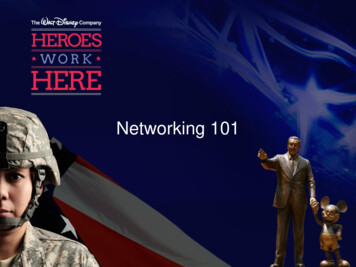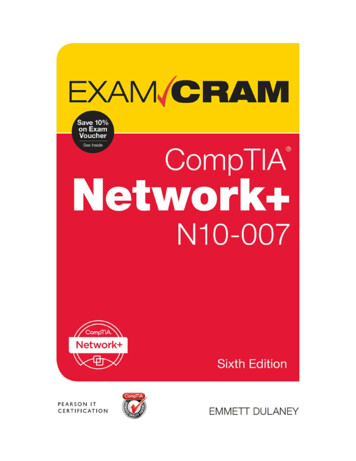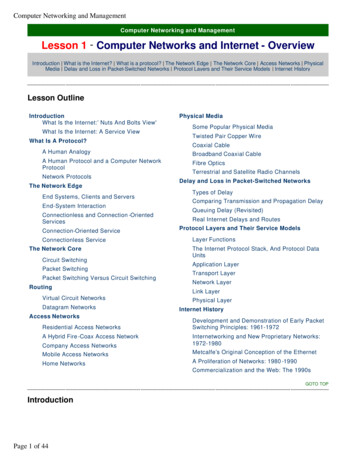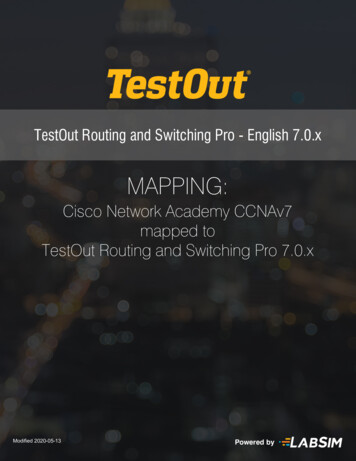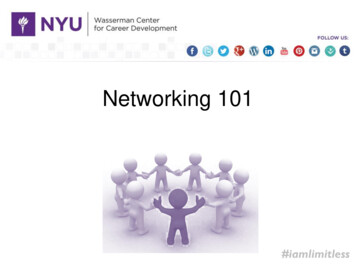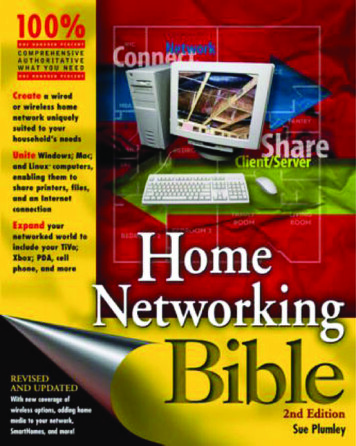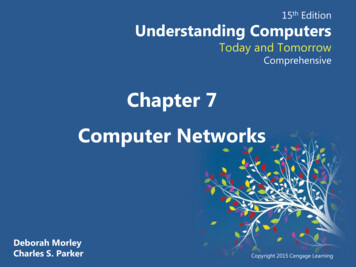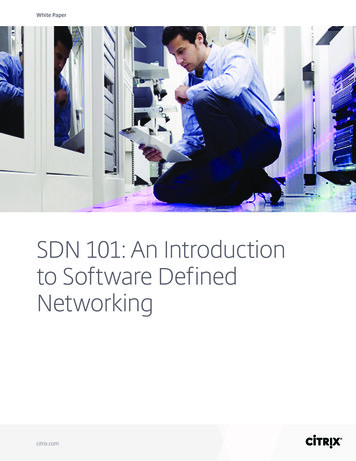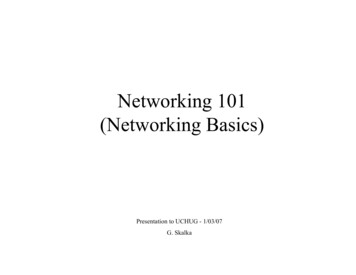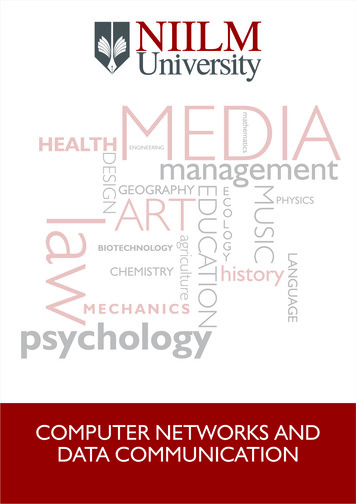
Transcription
Introduction toComputer NetworkingChapter 1Silvia GiordanoICA, EPFLCH-1015 ch1: Introduction11
IntroductionChapter goal: understand TCP/IP and networking terminology more depth, detail later in course approach: Top-down descriptive use Internet as exampleText Books:“Computer Networking”, J. Kurose – K. Ross, Addison Wesley“TCP/IP illustrated volume I”, The protocols, W. Richard Stevens,Addison Wesley (Very detailed, experimental hands-on descriptionof TCP/IP. Also volume III for HTTP)“Java Network Programming”E. Harold, O’Reilly (for Java sockets)1: Introduction2In this lecture we study computer networks.We use a top-down approach, starting with socket programming. We will study inthis chapter the global picture, which will enable you to get started with writingyour first programs. Then in the following chapters, we will study the variouscomponents (called “layers”), one by one.2
Overview what’s the Internet what’s a computer network what’s a protocol? protocol layers, service models network edge network core access net, physical media network delay and throughput history1: Introduction33
What’s the Internet: “nuts and bolts” view millions of connectedcomputing devices: hosts,end-systems pc’s workstations, serversPDA’s phones, toastersrouterserver regional ISPcommunication links mobilelocal ISPrunning network apps workstationfiber, copper, radio,satelliterouters: forward packets(chunks) of data thrunetworkcompanynetwork1: Introduction4In this course we use the public Internet, a specific computer network (and onewhich probably most readers have used), as our principle vehicle for discussingcomputer networking protocols.The public Internet is a world-wide computer network, that is, a network thatinterconnects millions of computing devices throughout the world. Most of thesecomputing devices are traditional desktop PCs, Unix-based workstations, and socalled servers that store and transmit information such as Web (WWW) pages ande-mail messages. Increasingly, nontraditional computing devices such as Web TVs,mobile computers, pagers, and toasters are being connected to the Internet. (Toastersare not the only rather unusual devices to have been hooked up to the Internet). Inthe Internet jargon, all of these devices are called hosts or end systems. The Internetapplications with which many of us are familiar, such as the Web and e-mail, arenetwork application programs that run on such end systems.4
What’s the Internet: “nuts and bolts” viewrouter protocols: control sending,receiving of msgs servere.g., TCP, IP, HTTP, FTP, PPPregional ISPnetworks” mobilelocal ISPInternet: “network of workstationloosely hierarchicalpublic Internet versusprivate intranetcompanynetwork1: Introduction5End systems, as well as most other "pieces" of the Internet, run protocols thatcontrol the sending and receiving of information within the Internet. TCP (theTransmission Control Protocol) and IP (the Internet Protocol) are two of the mostimportant protocols in the Internet. The Internet's principal protocols are collectivelyknown as TCP/IP.End systems are connected together by communication links. Links are made up ofdifferent types of physical media, including coaxial cable, copper wire, fiber optics,and radio spectrum. Different links can transmit data at different rates. The linktransmission rate is often called the link bandwidth and is typically measured inbits/second.Usually, end systems are not directly attached to each other via a singlecommunication link. Instead, they are indirectly connected to each other throughintermediate switching devices known as routers.The topology of the Internet, that is, the structure of the interconnection among thevarious pieces of the Internet, is loosely hierarchical. Roughly speaking, frombottom-to-top, the hierarchy consists of end systems connected to local Internetservice providers (ISPs) though access networks. An access network may be a socalled local area network within a company or university, a dial telephone line witha modem, or a high-speed cable-based or phone-based access network. Local ISPsare in turn connected to regional ISPs, which are in turn connected to national andinternational ISPs. The national and international ISPs are connected together at thehighest tier in the hierarchy. New tiers and branches (that is, new networks, and newnetworks of networks) can be added just as a new piece of Lego can be attached toan existing Lego construction.5
Computer NetworkA computer network provides several network services. network services examples: distributed database, Web (3) , file transfer, remote login,email,news, talk, remote processing, resource sharing (fileservers, printers, modems), network time, name service (2) user n/1name server2 query www. yahoo .com.answer www. yahoo .com.IP addr 216.32.74.53Web server3IP addr 216.32.74.53GET n.jpgdata (HTML page)1: Introduction6What are computer networks used for ?Computer networks allow people and machines to communicate, using a number ofservices. The slide shows a small subset of services.6
What are computer networksused for?1: Introduction77
Computer NetworkA computer network is made of network infrastructure: supports transport of data between computers wheredistributed applications residein computers (Ethernet card, modem software) in special network devices (bridges, routers,concentrators, switches)A computer network enables distributed applications provides service to users and applications on othermachines, or to other machinesis in computers1: Introduction8A computer network is made of two disctinct subsets of components- distributed applications are programs running on interconnected computers; a webserver, a remote login server, an email exchanger are examples. This is the visiblepart of what people call “the Internet”. In this lecture we will study the simplestaspects of distributed applications. More sophisticated aspects are the object oflectures called “Distributed Systems” and “Information Systems”.- the network infrastructure is the collection of systems which are required for theinterconnection of computers running the distributed applications. It is the mainfocus of this lecture.The network infrastructure problem has itself two aspects:- distance: interconnect systems that are too far apart for a direct cable to be possible- meshing: interconnect systems together; even in the case of systems located closeto each other, it is not possible in non-trivial cases to draw cables from all systemsto all systems (combinatorial explosion, cable salad management problems).The distance problem is solved by using a network, such as the telephone networkwith modems (see later). The meshing problem was originally solved easily becausethe terminals were not able to communicate with each other, but always has to gothrough a main computer. The mesh in such cases is reduced to a star network.Today this is solved by a complex set of bridges and routers.8
What’s the Internet: a service view Internet enablesdistributed applications: WWW, email, games, ecommerce, database.,voting,Two services connection-orientedconnectionless1: Introduction9The Internet allows distributed applications running on its end systems to exchangedata with each other. These applications include remote login, file transfer,electronic mail, audio and video streaming, real-time audio and video conferencing,distributed games, the World Wide Web, and much, much more.The Internet provides two services to its distributed applications: a connectionoriented service and a connectionless service. Loosely speaking, connectionoriented service guarantees that data transmitted from a sender to a receiver willeventually be delivered to the receiver in order and in its entirety. Connectionlessservice does not make any guarantees about eventual delivery.9
What’s a protocol?a human protocol and a computer network protocol:HiTCP connectionreq.HiTCP connectionreply.Got thetime?Get http://gaia.cs.umass.edu/index.htm2:00 file timeQ: Other human protocol?1: Introduction10It is probably easiest to understand the notion of a computer network protocol byfirst considering some human analogies, since we humans execute protocols all ofthe time. Consider what you do when you want to ask someone for the time of day.A typical exchange is shown in the figure. Human protocol (or good manners, atleast) dictates that one first offers a greeting (the first "Hi" in the figure) to initiatecommunication with someone else. The typical response to a "Hi" message (at leastoutside of New York City) is a returned "Hi" message. Implicitly, one then takes acordial "Hi" response as an indication that one can proceed ahead and ask for thetime of day. A different response to the initial "Hi" (such as "Don't bother me!" or "Idon't speak English," or an unprintable reply that one might receive in New YorkCity) might indicate an unwillingness or inability to communicate. In this case, thehuman protocol would be to not ask for the time of day. Sometimes one gets noresponse at all to a question, in which case one typically gives up asking that personfor the time.As an example of a computer network protocol with which you are probablyfamiliar, consider what happens when you make a request to a Web server, that is,when you type in the URL of a Web page into your Web browser. The scenario isillustrated in the right half of the figure. First, your computer will send a"connection request" message to the Web server and wait for a reply. The Webserver will eventually receive your connection request message and return a"connection reply" message. Knowing that it is now OK to request the Webdocument, your computer then sends the name of the Web page it wants to fetchfrom that Web server in a "get" message. Finally, the Web server returns thecontents of the Web document to your computer.10
What’s a protocol?protocols define format, order of msgs sent andreceived among network entities, and actionstaken on msg transmission, receipthuman protocols: humans specific msgs sent specific actionstaken when msgsreceived, or othereventsnetwork protocols: machines rather thanhumans all communicationactivity in Internetgoverned by protocols1: Introduction11Note that in our human protocol, there are specific messages we send, and specificactions we take in response to the received reply messages or other events (such asno reply within some given amount of time). Clearly transmitted and receivedmessages, and actions taken when these messages are sent or received or otherevents occur, play a central role in a human protocol. If people run differentprotocols (for example, if one person has manners but the other does not, or if oneunderstands the concept of time and the other does not) the protocols do notinteroperate and no useful work can be accomplished. The same is true innetworking--it takes two (or more) communicating entities running the sameprotocol in order to accomplish a task.A network protocol is similar to a human protocol, except that the entitiesexchanging messages and taking actions are hardware or software components of acomputer network, components that we will study shortly in the following sections.All activity in the Internet that involves two or more communicating remote entitiesis governed by a protocol. Protocols in routers determine a packet's path from sourceto destination; hardware-implemented protocols in the network interface cards oftwo physically connected computers control the flow of bits on the "wire“ betweenthe two computers; a congestion-control protocol controls the rate at which packetsare transmitted between sender and receiver. Protocols are running everywhere inthe Internet, and consequently much of this course and also the project is aboutcomputer network protocols.11
Protocol “Layers”Networks are complex! many “pieces”: hosts routers links of variousmedia applications protocols hardware,softwareORGANIZATIONBYLAYERS1: Introduction1212
Organization of air travelticket (purchase)ticket (complain)baggage (check)baggage (claim)gates (load)gates (unload)runway takeoffrunway landingairplane routingairplane routingairplane routing a series of steps1: Introduction13The airline system: a human example of layering.How would you find the structure to describe this complex system that has ticketingagents, baggage checkers, gate personnel, pilots, airplanes, air traffic control, and aworldwide system for routing airplanes? One way to describe this system might beto describe the series of actions you take (or others take for you) when you fly on anairline. You purchase your ticket, check your bags, go to the gate, and eventually getloaded onto the plane. The plane takes off and is routed to its destination. After yourplane lands, you de-plane at the gate and claim your bags. If the trip was bad, youcomplain about the flight to the ticket agent (getting nothing for your effort).13
Organization of air travel: a different viewticket (purchase)2baggage (check)1ticket (complain)baggage (claim)gates (load)gates (unload)runway takeoffrunway landingairplane routingairplane routingairplane routingLayers: each layer implements a service via its own internal-layer actions (1) relying on services provided by layer below (2)1: Introduction14However, this is not very efficient. A better structure results if we can look at thefunctionality in a horizontal manner, as shown in the figure. In the figure, the airlinefunctionality are divided into layers, providing a framework in which we can discussairline travel. Now, when we want to describe a part of airline travel, we can talkabout a specific, well-defined component of airline travel. For example, when wediscuss gate functionality, we know we are discussing functionality that sits "below"baggage handling, and "above" takeoff and landing. We note that each layer,combined with the layers below it, implement some functionality, some service.14
Layered air travel: servicesCounter-to-counter delivery of person bagsbaggage-claim-to-baggage-claim deliverypeople transfer: loading gate to arrival gaterunway-to-runway delivery of planeairplane routing from source to destination1: Introduction15Each layer provides its service by (1) performing certain actions within that layer(for example, at the gate layer, loading and unloading people from an airplane) andby (2) using the services of the layer directly below it (for example, in the gatelayer, using the runway-to-runway passenger transfer service of the takeoff/landinglayer).15
ticket (purchase)ticket (complain)baggage (check)baggage (claim)gates (load)gates (unload)runway takeoffrunway landingairplane routingairplane routingarriving airportDeparting airportDistributed implementation of layer functionalityintermediate air traffic sitesairplane routingairplane routingairplane routing1: Introduction16The layered airline architecture is distributed between the departing and arrivingairports.16
Why layering?Dealing with complex systems: explicit structure allows identification,relationship of complex system’s pieces layered reference model for discussion modularization eases maintenance, updating ofsystem change of implementation of layer’s servicetransparent to rest of system e.g., change in gate procedure doesn’t affectrest of system1: Introduction17To reduce design complexity, network designers organize protocols--and thenetwork hardware and software that implements the protocols--in layers. With alayered protocol architecture, each protocol belongs to one of the layers. It'simportant to realize that a protocol in layer n is distributed among the networkentities (including end systems and packet switches) that implement that protocol.As long as the layer provides the same service to the layer above it, and uses thesame services from the layer below it, the remainder of the system remainsunchanged when a layer's implementation is changed.17
Protocol, service and otherfancy definitions Peer entities two (or more) instances of the same layer Protocol and PDU: the “rules of the game” observed by peer entities the data exchanged is called PDU (protocol data unit) there is one protocol (or more) at every layer Service and SDU the interface between a layer and the layer above the interface data is called SDU (service data unit) Connection a protocol is connection oriented if the peer entity mustbe synchronized before exchanging useful data;otherwise it is connectionless.1: Introduction18A protocol is the formal definition of external behaviour for communicatingentities. It defines:- message formats- expected actions (message sent, data delivered, abort)Examples of protocols are:TCPUDPIPEthernetProtocols are connection oriented or connectionless. A connection exists if thecommunication requires some synchronization of all involved parties beforecommunication can take place. The telephone system is connection oriented: beforeA can send some information to B, A has to call B (or vice versa) and say “hello”.The postal (mail) system is connectionless. If A wants to send some information toB, A can write a letter and mail it, even if B is not ready to read it.Networking functions are ordered in a layered model:- layer n communicates with other layer n entities using the layer n protocol, thedeat units exchanged are called layer n PDUs (protocol data units)- layer n uses the service of layer n-1 and offers a service to layer n 1.- entities at the same layer are said peer entities.18
OSI Architectureend to end layersglobal layerlocal rLayer11: Introduction19The OSI architecture defines protocols and service specifications.It is the official standard, similar to the TCP/IP architecture, but is not much implemented. However, theOSI model is used most frequently to describe all systems, including TCP/IPArchitectures do not interoperate by themselves at the protocol level. For example, the OSI transport protocols arenot compatible with TCP or UDP. Worse, there is no compatibility at the service level, so it is not possible to uselayer n of one architecture and put it on top of layer n-1 of some other architectures.There are fortunately exceptions to this statement. Layer interfaces where service compatibility is oftenimplemented are:the data link layerthe transport layer.For example, it is possible to use various protocol families over the same local area network (LAN).The OSI presentation layer is in charge of hiding specific data representation formats. It defines ASN.1, anabstract, universal means for coding all types of data structures. ASN.1 has also become part of the TCP/IParchitecture, in the application layerThe OSI session layer synchronizes events between end-systems, in order for example to support failure recovery.It is implemented in TCP/IP over a number of application layer protocols and TCP.19
Internet protocol stack application: supporting networkapplications ftp, smtp, http transport: host-host data transfer tcp, udp network: routing of datagrams fromsource to destination ip, routing protocols link: data transfer betweenneighboring network elements ppp, ethernetapplicationtransportnetworklinkphysical physical: bits “on the wire”1: Introduction20The objective of this and the following slides is to introduce the concept of layers.Like any complex computer system, a network is decomposed into functions. Thisdecomposition is, to a large extend, stable: computer networking people have agreedon a reasonable way to divide the set of functions into what is called “layers”.The decomposition always assumes that the different components can be orderedsuch that one component interfaces only with two adjacent components. We call“layers” the components.20
Layering: logical communicationEach layer: distributed “entities” implementlayer gfunctions ateach node entities performactions, exchangemessages with peers1: Introduction2121
Layering: logical orklinkphysicalE.g.: transport take data from app add addressing,reliability checkinfo to formapplication“datagram”transport send datagram tonetworkpeerlinkphysical wait for peer toack receipt analogy: ransportnetworklinkphysical1: Introduction2222
Layering: physical caldataapplicationtransportnetworklinkphysical1: Introduction2323
Protocol layering and dataEach layer takes data from above adds header information to create new data unit passes new data unit to layer belowsourceMHt MHn Ht MHl Hn Ht ttransportHn HtnetworknetworklinkHl Hn ame1: Introduction2424
Physical LayerData Link Layerphysical transmission Physicalfunction bits - electrical / opticalsignals transmit individual bits over thecable: modulation, encoding packet transmission Data Linkfunction bits - frames bit error detection packet boundaries in some cases: error correction T1point to pointcables1“to T3:Hello”T22 “From T1:Hello”T3terminalsmainframecomputerby retransmission Modems, Ethernets1: Introduction25We start with the simplest, and oldest, network example: it is a mainframe connected to terminals. Inthat case, there are mainly two functions physical layer: translates bits into electromagnetic waves; data link layer: translates packets into bits.Physical Layer: The job of the physical layer is to move the individual bits within the frame from onenode to the next. The protocols in this layer are again link dependent, and further depend on the actualtransmission medium of the link (for example, twisted-pair copper wire, single-mode fiber optics). Forexample, Ethernet has many physical layer protocols: one for twisted-pair copper wire, another forcoaxial cable, another for fiber, and so on. In each case, a bit is moved across the link in a differentway.Link Layer: The services provided at the link layer depend on the specific link-layer protocol that isemployed over the link. For example, some protocols provide reliable delivery on a link basis, that is,from transmitting node, over one link, to receiving node. The process is analogous to the postal workerat a mailing center who puts a letter into a plane that will deliver the letter to the next postal centeralong the route. Examples of link layers include Ethernet and PPP; in some contexts, ATM and framerelay can be considered link layers. As datagrams typically need to traverse several links to travel fromsource to destination, a datagram may be handled by different link-layer protocols at different linksalong its route. For example, a datagram may be handled by Ethernet on one link and then PPP on thenext link. The network will receive a different service from each of the different link-layer protocols.25
Network Layer Network layer set of functions require to transport packetsend-to- end examples: IP, Appletalk, IPX intermediate system forwards data not destined to itselfM1T1M21T221a4, 6aT3T432a5apacket switch3a4asrce T2, dest M2, “to T3: hello”1: Introduction26Modern networks have more than physical and data link. The network layer is the set of mechanismsthat can be used to send packets from one computer to another in the world. There are two types ofnetworks:With Packet switching, data packets can be carried together on the same link. They are differentiatedby addressing information. Packet switching is the basis for all data networks today, including theInternet, public data networks such as Frame Relay, X.25, or ATM.Circuit Switching is the way telephone networks operate. A circuit emulates the physical signals of adirect end-to-end cable. When computers are connected by a circuit switched network, they establish adirect data link over the circuit. This is used today for modem access to a data network.Modern circuit switches are based on byte multiplexing and are thus similar to packet switches, withthe main difference that they perform non-statistical multiplexing (see later in this chapter).A network has Intermediate systems (ISs): those are systems that send data to next ISs or to thedestination. Using interconnected ISs saves cable and bandwidth. ISs are known under various termsdepending on the context: routers (TCP/IP, AppleTalk, ), switches (X.25, Frame Relay, ATM,telephone), communication controllers (SNA), network nodes (APPN).The Internet's network layer has two principle components. It has a protocol that defines the fields inthe IP datagram as well as how the end systems and routers act on these fields. This protocol is thecelebrated IP protocol. There is only one IP protocol, and all Internet components that have a networklayer must run the IP protocol. The Internet's network layer also contains routing protocols thatdetermine the routes that datagrams take between sources and destinations. The Internet has manyrouting protocols.26
Transport Layer Why a transport layer ? transport layer makes network service available toprogramsis end-to-end only, not in routersin TCP/IP there are two transport protocols UDP (user datagram protocol) unreliable offers a datagram service to the application (unit ofinformation is a message) TCP (transmisssion control protocol) reliable offers a stream service (unit of information is a byte) an application uses UDP or TCP, it is a designer’schoice use for example the socket API: a library of C functionssocket also means (IP address, port number) 1: Introduction27Physical, data link and network layers are sufficient to build a packet transport system betweencomputers. However, this is not enough for the programmer. When you write a low-level programwhich uses the network (as we will do in this lecture), you do not handle packets, but data. The primarygoal of the transport layer is to provide the programmer with an interface to the network.Second, the transport layer uses the concept of port. A port is a number which is used locally (on onemachine) and identifies the source and destination of the packet inside the machine. We will comeback to the concept of ports later in this chapter.The transport layer exists in two varieties: unreliable and reliable. The unreliable variety simply sendspackets, and does not attempt to guarantee any delivery. The reliable variety, in contrast, makes surethat data does reach the destination, even if some packets may be lost from time to time. In the Internetthere are two transport protocols, TCP and UDP, either of which can transport application-layermessages. TCP provides a connection-oriented service to its applications. This service includesguaranteed delivery of application-layer messages to the destination and flow control (that is,sender/receiver speed matching). TCP also segments long messages into shorter segments and providesa congestion control mechanism, so that a source throttles its transmission rate when the network iscongested. The UDP protocol provides its applications a connectionless service, which is very much ano-frills service.27
Application Layer application layer supports network application Many known protocols applications that are distributed into the networkapplications that communicates through the networkftp: file transfersmtp: email protocolhttp:web protocolan application uses UDP or TCP, it is a designer’schoice use for example the socket API: a library of C functionssocket also means (IP address, port number)1: Introduction28The Application Layer is responsible for supporting network applications. The application layerincludes many protocols, including HTTP to support the Web, SMTP to support electronic mail, andFTP to support file transfer. We shall see in Chapter 2 that it is very easy to create our own newapplication-layer protocols.28
A closer look at network structure: network edge:applications andhosts network core:routers network ofnetworks access networks,physical media:communication links1: Introduction29We are now going to delve a bit more deeply into the components of a computernetwork. We begin at the edge of network and look at the components with whichwe are most familiar--the computers (for example, PCs and workstations) that weuse on a daily basis. Then, moving from the network edge to the network core wehave switchs and routers. Finally, we have the access network – the physical link(s)that connect an end system to its edge router – that is, to the first router on a pathfrom the end system to any other end system.29
The network edge: end systems (hosts): run application programse.g., WWW, emailat “edge of network” client/server model client host requests, receivesservice from servere.g., WWW client (browser)/server; email client/server peer-peer model: host interaction symmetrice.g.: teleconferencing1: Introduction30In computer networking jargon, the computers that we use on a daily basis are oftenreferred to as hosts or end systems. They are referred to as hosts because they host(run) application-level programs such as a Web browser or server program, or an email program. They are also referred to as end systems because they sit at the edgeof the network.Hosts are sometimes further divided into two categories: clients and servers.Informally, clients often tend to be desktop PC
service providers (ISPs) though access networks. An access network may be a so-called local area network within a company or university, a dial telephone line with a modem, or a high-speed cable-based or phone-based access network. Local ISPs are in turn connected to regional ISPs, which


